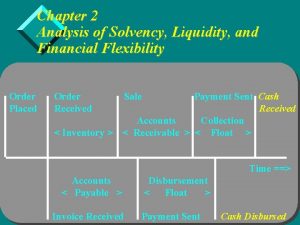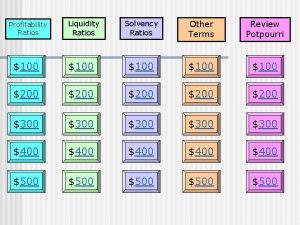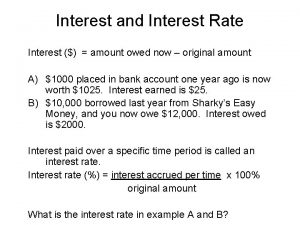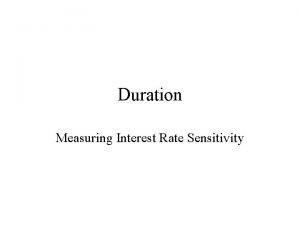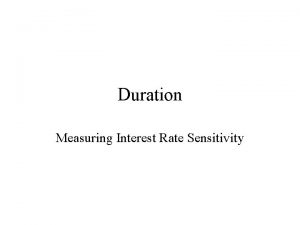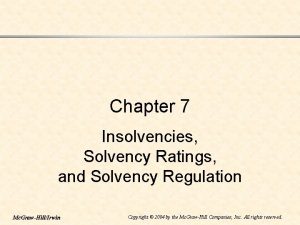Solvency II and the low interest rate environment












- Slides: 12

Solvency II and the low interest rate environment Olav Jones 8 October 2013

Insurance Europe Founded in 1953: 34 members from EU and related areas Insurance Europe represents 95% of European insurance market and more than 5 000 European (re)insurers, which: • generate premium income of more than € 1 100 bn • employ almost one million people • invest almost € 8 400 bn in the economy 2

Why has SII been delayed? Insurance industry has supported a risk-based system The Quantitative Impact Study in 2010 (QIS 5), combined with significant market turbulence, showed that Solvency II required adjustments to measure all risks correctly Delay until 2016 needed to get agreement on the changes and fix Solvency II so it will work as intended 3

Adjustments to Solvency II required to take into account long-term nature of industry Economic consequences of longterm liabilities Problems identified by QIS 5 in 2010 Solutions identified Insurance companies can reduce or eliminate their exposure to actual losses due to temporary falls in asset prices. Solvency II was assuming companies are always exposed to all market price movements. Adjust the measures to recognise the economic impact and benefits of the long-term model. Even if a change (eg shift to low interest rates) may be permanent, insurance companies usually have many years to address the issue. Solvency II was assuming that any shortfall must be immediately filled. This exaggerated the true risk and created enormous and unmanageable artificial volatility in the balance sheet. Include transition measures and extend recovery periods. This would create unnecessary financial distress. 4

Why this matters? Insurers’ long-term approach is vital For policyholders Access to a wide range of long-term products Access to additional yield from investing long-term Sharing/pooling of investment returns among policyholders over time For the wider economy Largest institutional investor, with a long-term perspective Stable funding for economic growth Stability and counter-cyclical role during crisis 5

With over € 8 400 bn of assets, getting Solvency II right is key 6

Balance sheet volatility has a very large impact on the actual capital companies will in practice need to hold Buffer needed to cope with balance sheet volatility Surplus Available capital Assets Risk margin Best estimate liabilities Value of assets SCR Total capital companies will need to allocate to meet Solvency II requirements as well as coping with volatility created by the Solvency II measure Liabilities Capital (Own funds) 7

Example 1: How much volatility would Solvency II have created without adjustments? 8

Package of solutions under discussion is not ideal but can avoid Solvency II causing unnecessary damage Adjustment What it is meant to achieve Matching Adjustment Recognise that in certain cases insurers can eliminate exposure to asset price volatility (but is exposed to risk of actual default) Volatility Adjustment Recognise that even where conditions for Matching Adjustment are not met, companies are not fully exposed to asset volatility Extrapolation Recognise that risk free curve needs to be extended because liabilities can be longer than available market data Transitional measures Recognise that long-term nature of business means that insurance companies both need and have time to adapt from previous regime, products and market situations to new one Extension of recovery period Give more time to deal with exceptional situations, such as falls in financial markets 9

What does this mean for low interest rates? Current low interest rate environment is difficult for some companies The volatility adjustment will better reflect the economic position of the company and avoid exaggerating the low interest rate issues faced by companies with a mismatch The transition measures will provide time for companies to adapt, however companies should not delay in addressing the issue Solvency II will encourage new products to be designed in a way that can cope with the full range of interest rate conditions 10

Example 2: Why transition measures are so important to deal with the current low interest rates Solvency problems: can be due to current market conditions => might only be temporary the long-term nature of the business means that there may be many years to allow for solving There is a difference between: Immediate shortfalls (eg € 200 m due to a windstorm) Future shortfalls (eg € 200 m due to current low interest rates) 11

Likely impact of Solvency II Impact will depend on how Solvency II is finalised Appropriate package of adjustments to Omnibus II to cope with longterm issues Appropriate implementation where there are still a large number of improvements needed (implementing measures) If we get a reasonable set of solutions then Solvency II will likely lead to: Better risk management and very high standards of protection for policyholders Better matching of assets and liabilities Product pricing better reflecting the real risks Changes in product design (especially on guarantees) 12
 What is real interest rate and nominal interest rate
What is real interest rate and nominal interest rate Cap rate interest rate relationship
Cap rate interest rate relationship 0 965
0 965 Emotive communication style
Emotive communication style Liquidity profitability and solvency
Liquidity profitability and solvency Liquidity profitability and solvency
Liquidity profitability and solvency Solvency formula
Solvency formula Nominal rate of interest
Nominal rate of interest Mid = low + (high - low) / 2
Mid = low + (high - low) / 2 Low accuracy low precision
Low accuracy low precision Low voltage = low hazard
Low voltage = low hazard Money demand and interest rate
Money demand and interest rate International arbitrage and interest rate parity
International arbitrage and interest rate parity




